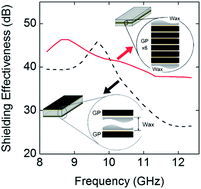Facile fabrication of ultrathin graphene papers for effective electromagnetic shielding†
Abstract
Ultrathin electromagnetic interference (EMI) shielding materials promise great application potential in portable electronic devices and communication instruments. Lightweight graphene-based materials have been pursued for their exclusive microstructures and unique shielding mechanism. However, the large thickness of the current low-density graphene-based composites still limits their application potential in ultrathin devices. In this work, a novel approach has been taken to use conductive graphene paper (GP) in the fabrication of ultrathin EMI shielding materials. The as-prepared flexible GPs exhibit highly effective shielding capabilities, reaching ∼19.0 dB at ∼0.1 mm in thickness and ∼46.3 dB at ∼0.3 mm in thickness, thus the thinnest GPs having the best shielding performance among graphene-based shielding materials. Double-layered shielding attenuators have been designed and fabricated for a high shielding performance of up to ∼47.7 dB at a GP thickness of ∼0.1 mm. Mechanistically, the high performance should be due to Fabry–Pérot resonance, which is unusual in carbon-based shielding materials. The preparation of conductive GPs of superior shielding performance is relatively simple, amenable to large-scale production of ultrathin materials for EMI shielding and electromagnetic attenuators, with broad applications in lightweight portable electronic devices.

- This article is part of the themed collection: JMC C Top Picks collection: The many faces of carbon

 Please wait while we load your content...
Please wait while we load your content...